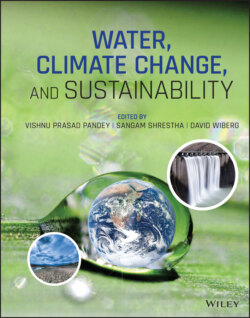Читать книгу Water, Climate Change, and Sustainability - Группа авторов - Страница 25
2.2. IMPLEMENTATION FRAMEWORKS FOR SDGS
ОглавлениеEven after five years since the adoption of SDGs in 2015, there are ambiguities on the implementation framework from the angle of institutional setup, mobilization of resources, ensuring participation, and for tracking progress. The approaches adopted by countries are diverse not only because of their local circumstances but also due to the loose governance of SDGs adopted during its foundation. Monitoring and accountability frameworks for SDGs exist (Fonseca et al. in this publication; Chapter 9), however, due to its non‐binding nature, there is no strict compliance on the countries which can formally submit voluntary national reviews (VNRs) to the High Level Political Forum for follow‐up and review of the 2030 Agenda for Sustainable Development (UNDESA 2019). By the means of VNR, countries take stock of and assess progress – and shortcomings – in implementation of the goals and targets. In that regard, many national governments have set up SDG implementation structures and are taking steps to integrate SDGs into national planning (Elder and King 2018). Some countries have tasked their planning commission to coordinate and track implementation SDGs, while in some cases a new institutional setup for SDGs has been created. For overwhelming countries, a pragmatic strategy is to mainstream existing developmental programs and actions and then juxtapose the outcomes with the relevant SDG targets. However, at worst, and contrary to the spirit of integrated and indivisible SDGs, the countries may end up selecting a few of the SDGs as priority goals that fit current national agendas, ongoing data collection, and resource constraints (Elder and King 2018). There is also a growing tendency among the donors, development partners, and international organizations to incorporate contributions to SDGs while developing plans, programs, and actions. Despite considerable hope and enthusiasm raised by the SDGs, many governments and stakeholders have little idea on how to proceed with concrete actions (Elder and King 2018).
In the absence of clear guidance, self‐innovation is also happening on several fronts including local government, cities, private sector and business, youth group, etc. For instance, the World Business Council for Sustainable Development (WBSCD) provides a platform for their member companies to strategically integrate and contribute to a wide variety of SDGs. While, SDG Business Hub captures and packages latest insight, developments and emerging trends on the SDGs to support business in navigating this dynamic agenda. Local bodies or regional governments have adopted Voluntary Local Reporting (VLR) for an assessment of their progress of SDGs implementation and subsequently fed into the VNR. At the sectoral or thematic level of each SDG or target, some specialized UN agencies are involved as per their core mandate such as UNHABITAT for SDG11, FAO for SDG2, WHO for SDG3, and UN Water for SDG6.
SDG6 has the most positive interaction (indivisible, reinforcing, enabling) with all SDGs (UNU/UNOSD, 2013). However, outcomes could be counteracting, in particular, on ambient water quality (Target 6.3), water availability (Target 6.4) and ecosystems (Target 6.6) if care is not taken to reduce pollution, use water sustainably and protect ecosystems during the implementation of SDGs (UN‐Water 2016b). Besides, further analysis will be necessary to understand and assess the complex interactions among multiple SDGs. For instance, a nexus approach helps to understand and balance the competing sectors such as water, food, and energy. A study on the interaction between SDG2 (food), SDG6 (water), and energy (SDG7) has found that SDG 6 has the highest synergies, 124 positive interactions, and SDG 2 has the most negative interactions (Fader et al. 2018).
Developing an ability to utilize the strategic role of water in the implementation of SDGs are sure to result in multiple dividends while avoiding counteracting outcomes (Shivakoti and Bengtsson 2015, UN‐Water 2016a). However, an integrated approach is indispensable for the co‐implementation of these targets not only due to synergies or trade‐offs on the outcomes but also from the perspective of resources and finance. Enormousness of the scope of all 17 SDGs means that resources will be in high demand and challenging to secure for each SDG. Sooner or later, an integrated framing will be obvious choice to find an economically rational way to finance water related SDGs, effective mobilization of resources, and cross‐coordination.
